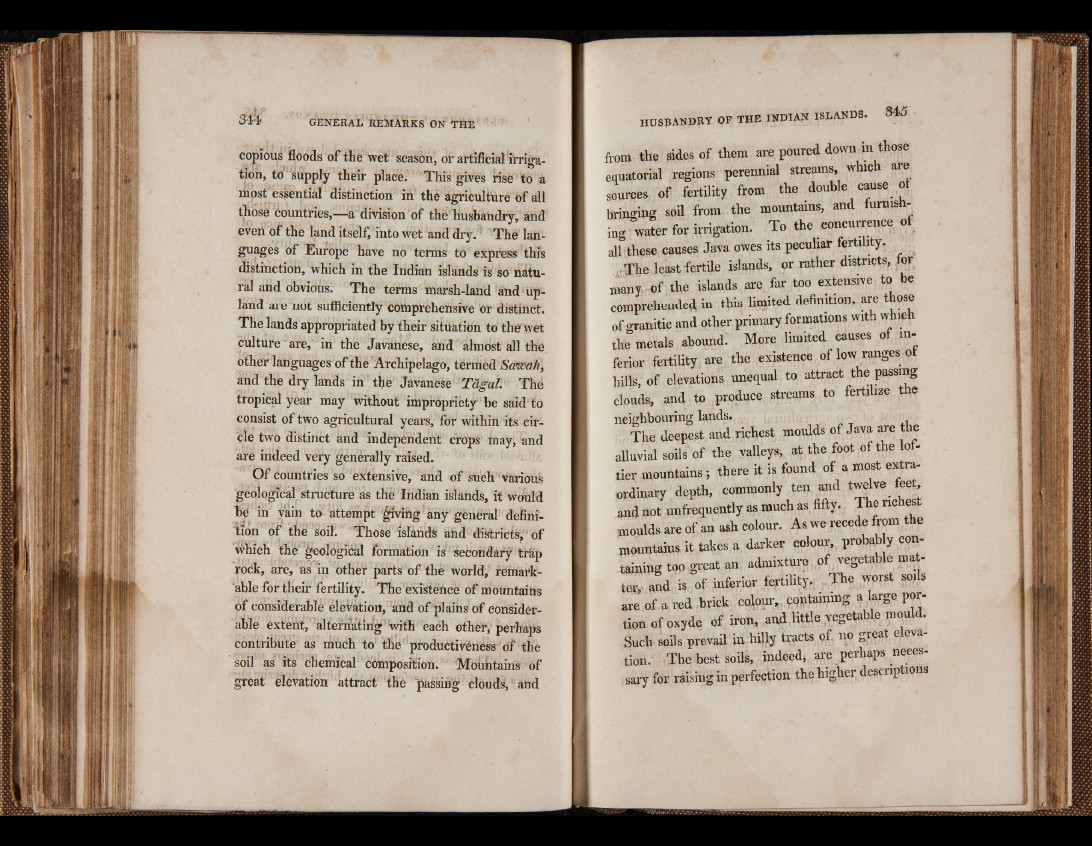
copious floods of the wet season, or artificial irrigation,
to supply their place. This gives rise to a
most essential distinction in the agricultiiré of all
those countries,-—a division of the husbandry, and
éveil of the land itself, into wet and dry. * Thé languages
of Europe have no terms to express this
distinction, which in the Indian islands is so natural
and obvions. The terms marsh-land and upland
are not sufficiently comprehensive or distinct.
The lands appropriated by their situation to thé wet
culture are," in the Javanese, and almost all thé
other languages of the Archipelago, termed Saxeah,
and the dry lands in the Javanese; Tâgat Thé
tropical year may without impropriety be said to
consist of two agricultural yearn, for within its circle
two distinct and independent crops may, and
are indeed very genérally raised. ' '
Of countries so extensive, and of such Various
geological structure as the Indian islands, it would
bé in vain to attempt ¿Mng any general definition
of the soiK* Those islands and districts, - of
which the geological formation is secondary trlip
rock, are, as in other parts of the world, remarkable
for their fertility. The existence of mountains
of considerable eleVation, and of plains of considerable
extent, alteraatirig with each other, perhaps
contribute as much to the productiveness of the
soil as' its chemical composition. Mohhtains* of
great elevation attract the passing clouds, and
from the sides of them are poured down in those
equatorial regions perennial streams, which are
sources of fertility from t h e double cause of
bringing soil from the mountains, and urms
ing water for irrigation. To the concurrence of
all these causes Java owes its peculiar fertility.
. The least fertile islands, or rather districts, for
many of the islands are far too extensive to be
comprehended ^ this limited definition, are those
of granitic and other primary formations with which
the metals abound: More limited causes of inferior
fertility are the existence of low ranges of
hills, of elevations unequal to attract the passing
clouds, and to produce streams to fertilize the
neighbouring lands.
The deepest and richest moulds of Java are the
aUuvial soils of the. valleys; at the foot of the loftier
mountains; there it is found of a most extraordinary
depth, commonly ten and twelve fee,
and not uufrequently as much as fifty- The richest
moulds are oí an ash colour. As we recede from the
mountains it takes a darker colour, probab y containing
too great an admixture of vegetable matte*,
and. is of inferior fertility. .The s0*
are of a red brick colour,, containing a large portion
of oxyde of iron, and little vegetable mould.
Such soils prevail in, hilly tracts of no great e eva
tion. The best soils, indeed, are perhaps neces